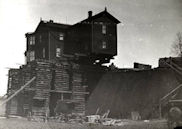When Omaha was founded, it looked very different from the city we know today. In the late 1800s and early 1900s, the streets of Omaha underwent a series of re-grading projects that drastically changed the city’s landscape. The level of the streets was lowered in some areas and raised in others. For example, in the late 1800s, at 17th and Farnam, the streets were lowered by 45 feet, and the dirt from this area was used to raise the grade between 20th and 24th Streets. Most buildings in the affected areas were moved to the new street level. Among the reasons for the re-grading, particularly in the later projects, was the need to make it easier for automobiles to navigate the steeply graded streets. In 1917, Dodge Street was re-graded from a 12% to a 7% grade so that cars would be able to more easily reach the top of the hill at 24th and Dodge Streets. (Source: National Register of Historic Places Registration Form for The Logan)

The Falconer residence, located at 1821 Douglas Street, was one of the buildings affected by street re-grading in the late 1800s. This series of photographs shows several images of the movement of the house, including a picture of it settled in its new position. Several other photographs of street re-grading work can be viewed in Nebraska Memories.
Visit Nebraska Memories to search for or browse through many more historical images digitized from photographs, negatives, postcards, maps, lantern slides, books and other materials.
Nebraska Memories is a cooperative project to digitize Nebraska-related historical and cultural heritage materials and make them available to researchers of all ages via the Internet. Nebraska Memories is brought to you by the Nebraska Library Commission. If your institution is interested in participating in Nebraska Memories, see http://www.nlc.state.ne.us/nebraskamemories/ for more information, or contact Beth Goble, Government Information Services Director, or Devra Dragos, Technology & Access Services Director.

